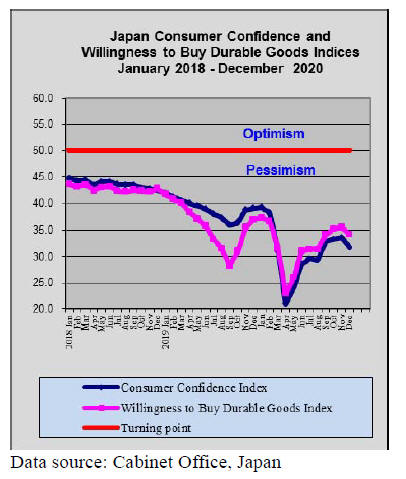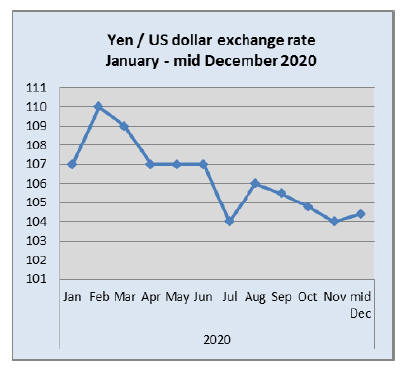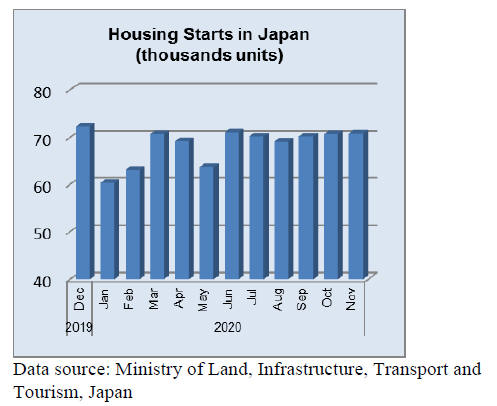Japan
Wood Products Prices
Dollar Exchange Rates of 11th
January
2021
Japan Yen 103.96
Reports From Japan
Recent infection
surge puts break on recovery
A recent survey found the majority of large Japanese
companies anticipate moderate economic growth in fiscal
2021. However, those in doubt said they are not sure when
sales will return to pre-pandemic levels.
The January 2021 surge in the spread of infections has put
a brake on the early signs of recovery reported in late
2020. The December 2020 and January 2021 the third
wave of infections has become critical and the government
has announced a state of emergency in the worst affected
prefectures.
The chairman of the Japan Business Federation has urged
cooperation between the public and private sectors to slow
the spread of the corona virus.
He said 2021 will be the year of revival, the key to which
is a digital transformation of the economy pointing out that
the administrative, medical and education systems in
Japan have been slow to see the advantages of expanded
digitalization.
See:
https://japantoday.com/category/business/business-leadersvow-to-revive-pandemic-hit-economy-with-innovation
Not surprising ¨C consumer confidence falls
For the first time in four months the consumer confidence
index for December released by the Cabinet Office
declined, driven down by a resurgence of coronavirus
infections across the country.
The index of sentiment among households fell to 31.8
from 33.7 in November. The index provides an indication
of consumers expectations for the coming six months. A
reading below 50 suggests pessimists outnumber
optimists. Of concern for exporters of wood products the
index for the December index for willingness of Japanese
consumers to purchase durable goods dropped sharply
from a month earlier.
The result of the latest survey was conducted in late
December as the country began to see a third wave of
virus infections. In response to the rapid spread of
infections the government has declared a state of
emergency for 11prefectures and it went into effect on 7
January and will remain in place for a month.
Late 2020 retail sales continued the downtrend and Tokyo
consumer prices declined at the fastest rate in 10 years as
record virus cases kept shoppers at home and darken the
recovery outlook. Retail sales fell 2% in November from
the prior month, as consumers continued to cut back on
apparel purchases, the economy ministry reported Friday.
See:
https://financialpost.com/pmn/business-pmn/japans-retailsales-resume-falling-amid-virus-resurgence

BoJ determined to stem any yen rise
The Japanese government and Bank of Japan (BoJ) have
reaffirmed they will work together to ensure the stability
of the yen after the currency recently rose to a 10-month
high of 102 against the US dollar.
Rising perceptions of risk and an uncertain economic
outlook as a third wave of corona infections spreads across
Japan could impact the exchange rate but the government
has made it clear that it will take all appropriate measures
to ensure a strengthening of the yen will not undermine the
price competitiveness of Japanese exports.

Land prices falling
Land prices in 38 of 100 commercial and residential
districts in Tokyo, Osaka, Nagoya and other cities have
been falling according to the latest land value report issued
by the Ministry of Land, Infrastructure, Transport and
Tourism. The data marked the first time since 2012 that
the number of districts seeing price declines outnumbered
areas with rising prices. Experts say the scale of the drop
is similar to that in 2008 during the global financial crisis.

Wooden door Imports
October imports
In October 2020 two shippers accounted for 86% of
Japan¡¯s imports of wooden doors (HS 441820), China,
54% and the Philippines 32%. Year on year the value of
October 2020 imports was down 15% but month on month
the value of imports barely changed.

Wooden window imports
October imports
The value of October 2020 wooden window (HS441810)
imports dropped 28% year on year and month on month
imports were down 25%. Some 95% of October 2020
wooden window imports were provided by three shippers,
China (49%), the US (23%) and the Philippines (23%).

Assembled wooden flooring imports
October imports
HS441875 continued to dominate Japan¡¯s imports of
assembled flooring in October 2020 accounting for around
73% of the various categories imported most shipped from
China, Malaysia and Indonesia.
HS441879 accounted for 14% of the value of October
imports. Year on year the value of October 2020 imports
dropped a massive 41% and compared to the value of
September imports there was a 21% decline.

Plywood imports
October imports
Between February and July 2020 there was a steady
decline in the volume of plywood imports. Imports in
August tipped higher only to be followed by a further
decline in September. This decline was reversed in
October 2020 when the volume of imports jumped 40%
compared to a month earlier. However, year on year
October 2020 impoirt volumes were down 17%.
Year on year the main plywood suppliers to Japan saw
sharp declines in the volume of shipments except
Malaysia. October 2020 shipments from Indonesia were
down 27% year on year and there was a 20% decline in
shipments from Vietnam.
It is noteworthy that the volume of shipments from
Vietnam exceeded those from China for the 10 months to
Octber 2020. The surge in the volume of October 2020
imports benefitted all the main suppliers with Malaysia
notching up a 40% increase in shipments.
Of the various categories imported HS441231 accounted
for over 80% of imports with a further 5% each being of
HS441233 and HS441234.


Trade news from the Japan Lumber Reports (JLR)
The Japan Lumber Reports (JLR), a subscription trade
journal published every two weeks in English, is
generously allowing the ITTO Tropical Timber Market
Report to reproduce news on the Japanese market
precisely as it appears in the JLR.
For the JLR report please see:
https://jfpj.jp/japan_lumber_reports/
2020 Agriculture and Forestry census
The Ministry of Agriculture, Forestry and Fisheries
announced 2020 agriculture and forestry census.
This is the investigation made every five years to see
actual status of domestic agriculture and forestry in terms
of production, employment and resources. 2020 census
was made based on the replies of questionnaires made in
February 2020. Management bodies of forest industry
were 140,000 in 2010 then 87,000 in 2015 and 34,000 in
2020.
Percentage of number of timber owners with more than 20
hectares was 19.4% in 2010, 22.1% in 2015 and increased
to 32.6% in 2020. This shows increase of timberland one
owner has. Timber harvest volume by forest management
bodies was 15,621,000 cbms in 2010, 19,888,000 cbms in
2015 and 22,597,000 cbms in 2020.
Production per owner increased by introducing high
performance harvesting machines.
Size of forestland is 24,770,000 hectares and percentage of
forestland in total area is 66.4%. In forestland, 13,560,000
hectares are privately owned, 54.7%, 7,150,000 hectares
of national forest, 28.9% and 3,410,000 hectares of public
owned, 13.8%. 650,000 hectares of independent
administrative corporation.
By the areas, Hokkaido, North East and Chubu region
have heavy percentage of forestland. As to log production,
Hokkaido, North East and Kyushu are top three. Number
of forest management body is heavy in Hokkaido,
Miyazaki prefecture in Kyushu and Iwate prefecture in the
North East region.
Percentage of agricultural community reserves local
resources such as agricultural drainage, reservoir,
farmland and forestland increased since 2015. Percentage
of community to preserve forest resources increased from
22.8% in 2015 to 27.4% in 2020.
Active domestic lumber market
Domestic lumber market in Tokyo region has been firming
with active demand. As the housing starts did not drop as
much as initially feared, movement of lumber is getting
busy since late October. Sawmills are not able to increase
the production because of tight log supply. Supply of KD
cedar post, cedar stud and cypress sill and post is tight.
The prices of 3 meter KD cedar post were less than 40,000
yen in August but now they climbed to 48,000-50,000 yen.
4 meter KD cypress sill prices were 55,000 yen in August
but now they are up to 58,000-61,000 yen.
Compared to the bottom of last summer, the prices are
generally increased by 5,000-10,000 yen but sawmills
want to increase another 2,000- 3,000 yen because of high
log prices but the dealers say that the prices do not climb
despite supply shortage because total demand is about
10% less than last year so the demand has no strength to
push the prices further.
Post and sill moved actively in last two months so by order
of construction, purlin and girder should move in
December.
South Sea (tropical) logs
8,031 cbms of logs arrived in October, which is the last
shipment for Daishin Plywood, which will quit in March.
Other buyers have been using Daishin¡¯s ships to carry logs
jointly but it becomes difficult in 2021. The log importers
say that there will be two or three shipments of logs in
2021.
South Sea logs users need to switch to use veneer instead
of logs or use something other than South Sea logs.
Demand of Chinese and Indonesian made South Sea
laminated free board is very active in the market and the
suppliers plan to increase the prices.
Then container freight is climbing by supply shortage and
nobody know how high it would climb so the importers
are in a hurry to import as soon as possible. However,
demand at end users is not real active so if arrivals come
together, there would be over-supply.
North American logs
Export prices of Douglas fir logs of December shipment
for Japan are reported to stay unchanged after North
American lumber market prices plunged. Log market
prices in North American are firm and unchanged from
November.
Export prices are not so profitable for the suppliers but the
export prices for Japan increased successively for four
months from August to November. Compared to the
bottom of last July, the increase is US$140 per M Scribner
or by 17.1%.
Meantime, Douglas fir lumber prices in Japan are up by 5-
6% or 3,000 yen per cbm after the largest manufacturer
made price hike on square and other standard lumber but
the prices of the main product of KD beam remain
unchanged due to competition with European redwood
laminated beam.
The supplier considers protection of Japan market. Two
years ago, Douglas fir log FAS prices for Japan climbed
over US$1,000, which resulted in drop out of the second
largest Douglas fir lumber manufacturer in Japan. This is
bitter experience for the log supplier.
|